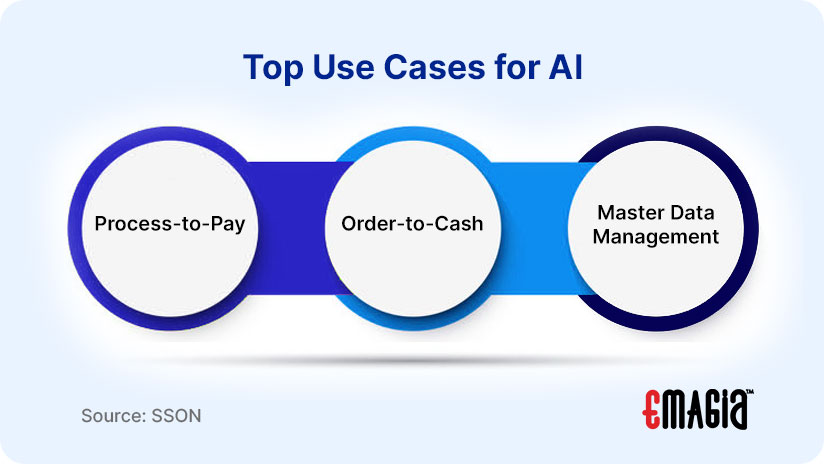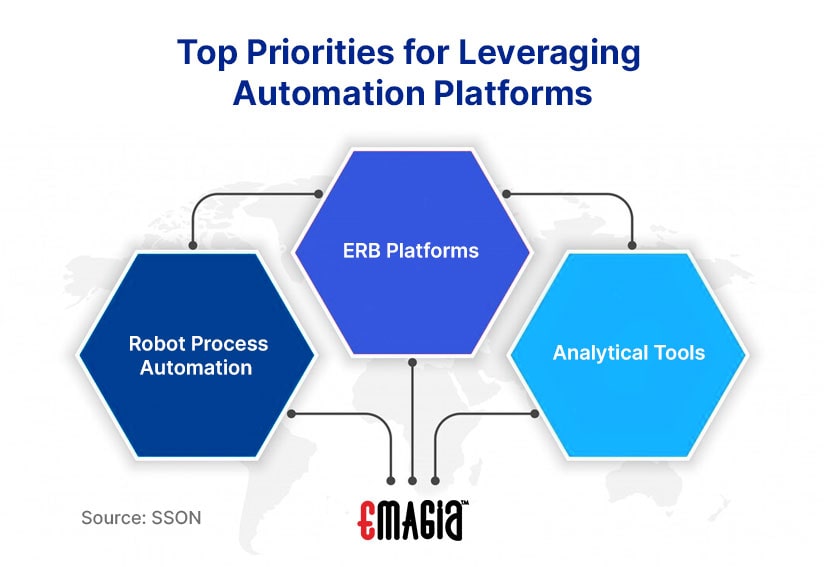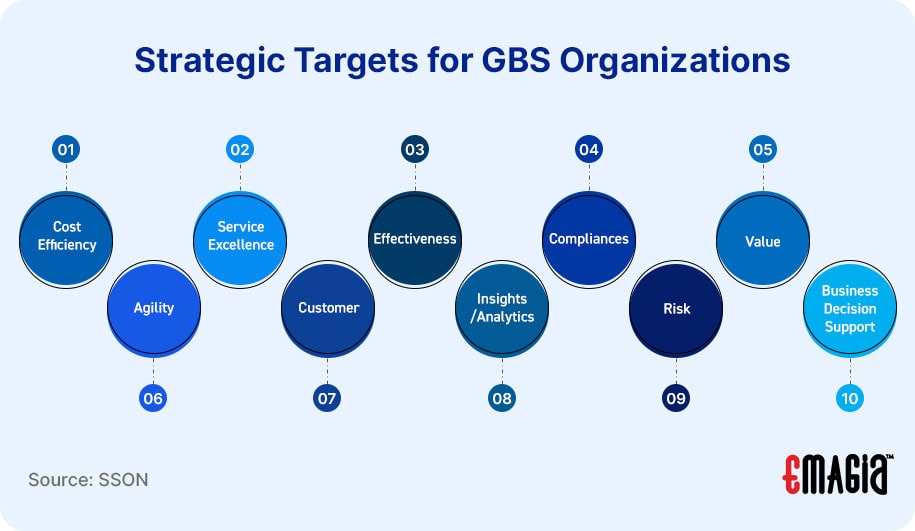Generative AI is changing the face of shared services organizations (SSO) and global business services (GBS), but the biggest challenge that companies face in implementing the new technology is finding the capabilities within their teams to put the technology into practice. The skills to do so are at a premium.
Adoption of the GBS model is growing, with more than two-thirds of those surveyed already running as GBS and 85% of SSO/GBS companies planning to expand their services, according to insights from the recent SSON Research and Analytics webinar “Global State of the Industry: SSO/GBS Outlook 2025.” About the same percentage already supports a digital agenda.
And GenAI is at the forefront of that change.
Generative Business Services
There is an ongoing discussion of whether the GBS model is working and if the “G” in GBS should be changed from “Global” to “Generative,” according to Tom Bangemann, head of data development and research for SSON (The Shared Services and Outsourcing Network).
Adoption of new technology is often discussed and growing, but universal adoption has yet to come to fruition. Half of the companies surveyed in SSON’s recent survey rated their own automation levels a medium. Only 17% gave their respective companies a “high” level assessment. Moreover, about one-third characterized their automation as essentially nonexistent.
“We’re not done by far,” said Bangemann, adding that significant room exists for companies to utilize the technological tools for automation they already have or can easily access.

When asked what best defines their current stage of intelligent automation, a third of companies said it was already implemented and a third were planning on implementation. The results indicated the most successful use cases for automation were reported to be Process-to-Pay followed by Order-to-Cash. When reporting on the maturity of their analytics implementation, one-third of companies replied “reporting,” a third “advanced reporting,” and some noted it was still early days. They may still be figuring out how to utilize the technology, according to SSON.
Partnering for Change
As far as adopting and planning on leveraging GenAI, 44% of companies plan on “upskilling” their internal teams to enable the technology, while 18% said they would partner with a company to do so.
What is slowing down implementation? Internal team capabilities, according to the report. Companies encounter difficulty in finding people with the skills to implement AI technology.
Among the top objectives for the future, nearly half of the companies surveyed named leveraging automation platforms as an objective. The top three technology investment priorities for the next year were listed as Robot Process Automation, ERP Platforms, and analytical tools.
One-third of surveyed companies asserted that they had already been successfully implemented when asked what best defines their current stage of intelligent automation, while an equal portion disclosed active plans for implementation. Notably, the survey underscored the triumphs in automation deployment, with Process-to-Pay emerging as the most successful use case, closely followed by Order-to-Cash. Delving into analytics, one-third of companies identified their current maturity level as “reporting,” another one-third as “advanced reporting,” and some acknowledged that they are still in the early stages of exploring analytics capabilities, as suggested by SSON.
Examining the trajectory of analytics implementation, companies appear to be at varying stages of maturity, with a notable emphasis on reporting capabilities. This diversity in responses indicates a spectrum of companies, some of which are still navigating the early phases of understanding how to harness analytics technology effectively.
Strategic Collaborations for Future Success
In the realm of generative AI, 44% of companies are strategically focused on “upskilling” their internal teams to adeptly embrace this transformative technology, while 18% have opted for strategic partnerships with external entities. The pursuit of upskilling underscores a commitment to fostering internal expertise, while collaborative efforts with external entities signal a recognition of the importance of external knowledge infusion.
Overcoming Implementation Challenges
But the primary impediment to swift implementation, as highlighted in the report, continues to revolve around internal team capabilities. The scarcity of skilled individuals proficient in AI technology implementation poses a considerable challenge for companies aspiring to integrate intelligent automation seamlessly into their operations.
It’s a sentiment that was echoed repeatedly during a Gartner webinar that occurred just days after SSON’s presentation of their findings. A key takeaway from Gartner leadership was that companies aren’t looking to replace staff with GenAI robots, but they are looking to hire and retain professionals with increasing levels of GenAI business use cases.
Future Aspirations and Technology Investment Priorities
Looking ahead, nearly half of the surveyed companies have identified leveraging automation platforms as a key objective for the future. In terms of technology investment priorities for the upcoming year, the top three areas of focus are Robot Process Automation, ERB Platforms, and analytical tools. These priorities align with the overarching objective of enhancing operational efficiency and leveraging the full potential of emerging technologies to drive sustained success.

Effective Implementation: One Size Does Not Fit All
Effective application of generative AI is a challenge. According to a recent report from The Hackett Group, generative AI can deliver a 40% reduction in selling, general, and administrative (SG&A) tasks and a 40% reduction in SG&A staff over five to seven years. The firm added, however, that companies must learn how best to apply generative AI in their respective environments.
The Hackett Group noted that generative AI will provide significant new opportunities for organizations, including improved competitive positioning, new market opportunities, and better customer satisfaction. Hackett’s leadership advises talking with credible technology, solution, and business process outsourcing providers to grasp GenAI capabilities and road maps.
Meanwhile, Forrester predicts unprecedented business value will be created as companies leverage AI to create an environment that promotes interdisciplinary teamwork, continuous learning, and alignment with a broader business strategy. Enterprise AI initiatives will boost productivity and creative problem solving by 50%, according to its recent set of predictions for 2025.
Increasing Outsourcing
SSON’s data shows that companies plan to increase outsourcing. About half of the companies surveyed outsource, with 41% saying outsourcing will increase in the next year. Benefits to outsourcing included access to improved automation and access to talent. Skills and capabilities were listed as the most effective factors in driving the process of optimization, followed by tools and solutions. There is a emerging trend to open more locations in the future in order to tap more labor pools for the skills and capabilities needed to support expansion.
For 2023, the list of services provided by SSO/GBS organizations has expanded, with Purchase-to-Pay in the top spot, followed by Order-to-Cash and Master Data Management.
As generative AI grows in importance for shared services and global business systems, outsourcing to external companies to provide the skills and capabilities to implement the new technology may be at the forefront of efficient and effective AI adoption.
Strategic Evolution in Outsourcing Dynamics
The latest insights from SSON reveal a notable inclination among companies towards an increased focus on outsourcing. Approximately half of the surveyed companies currently engage in outsourcing, and 41% anticipate a surge in outsourcing activities in the coming year. The perceived advantages of outsourcing were underscored, with companies citing enhanced automation and access to more, specialized talent that is well-versed with AI and automation as key drivers for this strategic shift.
Recognizing the impact of skilled professionals on operational success, companies are already increasingly turning to outsourcing as a strategic avenue to access specialized expertise and talent. This aligns with the broader industry trend of acknowledging the critical role of human capital in fostering innovation and efficiency.
An emerging trend in response to the growing importance of skills and capabilities is the consideration of opening additional locations. Companies are strategically exploring the prospect of establishing more geographic footholds to tap into diverse labor pools, thereby ensuring access to the skills required to support expansion initiatives effectively.

FAQs
What Is GenAI?
Generative AI (or GenAI) incorporates prediction algorithms that can learn from existing material to generate new, realistic material that reflects the data it was trained on but doesn’t repeat it. It can produce a variety of novel content, including images, video, music, speech, text, and software code. It most commonly creates content in response to natural language requests. Complex math and enormous computing power are behind the trained models on which it is based.
Research and advisory company Gartner envisions GemAI as a general-purpose technology that will impact society and business in a way similar to the steam engine, electricity, and the internet.
How Is GBS Different From SSO?
Global business services (GBS) is a more mature and integrated version of the shared services model found in shared service organizations (SSOs). There has been an increased shift towards the GBS model over the past decade.
Shared services began as a trend in the 1980s, with a focus on delivering financial transaction processes in a way that centralized scale and efficiency while decentralizing service and innovation. In the past several years, the GBS model has elevated shared services by becoming an enterprise-wide model that is flexible enough to serve multiple business functions.
One of the core differences between GBS and SSO is that, instead of operating multiple shared services centers, GBS integrates governance, locations, and business practices for all shared services and outsourcing activities in a business.
GBS delivers business support functions to the core business through multiple service delivery models on a global basis. While shared services has traditionally been seen as a support function, the GBS model operates as a business partner to help the organization meet strategic objectives.








